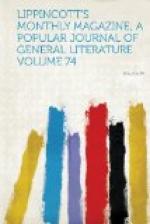you enjoy long-sightedness in a remarkable degree.”
The empress wrinkled her nose, and presently observed:
“I think, countess, I remember to have seen
your husband, General de Dempierre, in Russia.”
“Doubtless Your Majesty did so: he was the
first Frenchman that entered the Kremlin.”
The czarina was silent: the fall of Moscow was
not a pleasant subject of conversation to the wife
of Nicholas. The Villa de Diesbach comes next,
the winter residence of the historical family of that
name, into which married a few years since a tall,
gazelle-eyed American belle, Miss Meta McCall.
Then follows the pretty Villa Bouxhoevden, the property
of a Corlandese count of a very noble house, whose
wife hails from New Jersey. The countess is much
the fashion, and her hospitable house is a rendezvous
of the elite of the foreign and American colony.
She is a tall, graceful woman, with a pale and interesting
countenance, shadowed with clusters of light-brown
curls, which reminds one of Vandyke’s portraits
of Queen Henrietta Maria—a likeness somewhat
increased by costumes admirably suited to her style—long
flowing robes of rich silk trimmed with ermine and
costly lace. Then there is Mrs. Williams’s
garden, with Indian creepers and gaudy Eastern plants,
sent to her by her gallant son, the Crimean hero,
from the slopes of the Himalayas. Here on a Sunday
gathers a pleasant circle to drink five-o’clock
tea and listen to the bright remarks of Madame de
la Caume, the daughter of the hostess, who knows more
about French politics than many a deputy at Versailles.
But whilst we have been looking in at villa-gardens
the Promenade has filled up rapidly. A continuous
stream of carriages occupies the centre of the road,
a throng of gay folks animate with their showiest
toilets the oleander walk and the Jardin Publique,
where a tolerable band plays for two or three hours
thrice a week. The marble stairs of the Casino
are crowded with loungers, and the windows and balconies
of every villa are filled with well-dressed men and
women. Nowhere, perhaps, excepting in Rotten Row
or the Bois de Boulogne, can so many celebrated and
beautiful women and handsome or famous men be seen
parading up and down together as on the Promenade
des Anglais of a fine afternoon in the season.
Here gathers the creme de la creme of two worlds,
the Old and the New, Europe and America. In the
winter of 1870 the town was crowded to excess.
Never before were there so many notabilities assembled
at Nice—never was there so much gossip,
so much cancan and small talk. It was amusing
to sit in the shade of a palm tree on the promenade
and review the personae of this Vanity Fair.
Frederick Charles of Prussia and his princess in a
landau, with two Nubians on the box; the crown-princess
Victoria of England and her sister of Hesse-Darmstadt,
on a trip from Cannes, where they were then visiting;
Her Grace of Newcastle; De Villemessant of the Figaro,
in an invalid’s chair, the most accomplished




